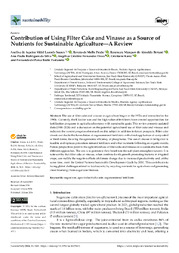Contribution of Using Filter Cake and Vinasse as a Source of Nutrients for Sustainable Agriculture—A Review.
Contribution of Using Filter Cake and Vinasse as a Source of Nutrients for Sustainable Agriculture—A Review.
Author(s): SOARES, A. DE A. V. L.; RODRIGUES, F. E.; MATTOS, E. C.; URBANO, L. H.; PRADO, R. DE M.; BERTANI, R. M. DE A.; SILVA, A. P. R. DA; DEUS, A. C. F.; KANO, C.; FURLANETO, F. DE P. B.
Summary: Abstract: The use of filter cake and vinasse in agriculture began in the 1970s and intensified in the 1990s. Currently, the Ukraine war and the high value of fertilizers have created opportunities for fertilization programs in agricultural systems with sustainable goals. This review presents updated data (1988–2024) and a discussion on the potential agricultural use of filter cake and vinasse and indicates the current progress of research on this subject in addition to future prospects. Filter cake stands out due to the formulation of organomineral fertilizers with direct application of composted or fresh forms, favoring the agronomic efficiency of phosphorus. The use of vinasse in fertigation is feasible and replaces potassium mineral fertilizers and other nutrients following an organic matrix. Future perspectives point to the agricultural use of filter cake and vinasse on a sustainable basis from different approaches. The aim is to potentiate their benefits in the soil-plant-atmosphere system. It is noteworthy that filter cake or vinasse, when combined with growth-promoting bacteria in irrigated crops, can nullify the negative effects of climate change due to increased productivity and, at the same time, meet the United Nations Sustainable Development Goals by 2030. This contributes to facing global challenges related to food security by recycling nutrients for agriculture and generating clean bioenergy from sugarcane biomass.
Publication year: 2024
Types of publication: Journal article
Unit: Embrapa Territorial
Keywords: Agro-industrial waste, Organomineral fertilizers, Sugarcane
Observation
Some of Embrapa's publications are published as ePub files. To read them, use or download one of the following free software options to your computer or mobile device. Android: Google Play Books; IOS: iBooks; Windows and Linux: Calibre.
Access other publications
Access the Agricultural Research Database (BDPA) to consult Embrapa's full library collection and records.
Visit Embrapa Bookstore to purchase books and other publications sold by Embrapa.

